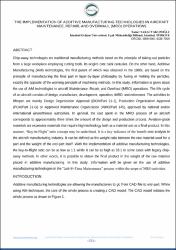| dc.contributor.author | Saraçyakupoğlu, Tamer | |
| dc.date.accessioned | 2021-11-23T12:43:10Z | |
| dc.date.available | 2021-11-23T12:43:10Z | |
| dc.date.issued | 2021 | en_US |
| dc.identifier.isbn | 978-625-8007-59-6 | |
| dc.identifier.uri | https://hdl.handle.net/11363/3002 | |
| dc.description.abstract | Chip-away technologies are traditional manufacturing methods based on the principle of taking-out particles
from a large workpiece employing cutting tools. Its origins date back centuries. On the other hand, Additive
Manufacturing (AM) technologies, the first patent of which was obtained in the 1980s, are based on the
principle of manufacturing the final part in layer-by-layer philosophy by fusing or melting the particles,
exactly the opposite of the working principle of machining methods. In this study, information is given about
the use of AM technologies in aircraft Maintenance, Repair, and Overhaul (MRO) operations. The life cycle
of an aircraft consists of design, manufacture, development, operation, MRO, and retirement. The activities in
lifespan are mainly Design Organization Approval (DOA/Part 21-J), Production Organization Approval
(POA/Part 21-G) or Approved Maintenance Organization (AMO/Part 145), approved by national and/or
international airworthiness authorities. In general, the cost spent in the MRO process of an aircraft
corresponds to approximately three times the amount of the design and production process. Aviation-grade
materials are expensive materials that require high technology both as a material and as a final product. In this
manner, “Buy-to-Flight” ratio concept may be underlined. It is a key indicator of the benefit-cost analysis in
the aircraft manufacturing industry. It can be defined as the weight ratio between the raw material used for a
part and the weight of the end-part itself. With the implementation of additive manufacturing technologies,
the buy-to-flight ratio can be as low as 1:1 while it can be as high as 33:1 in some cases with legacy chipaway methods. In other words, it is possible to obtain the final product in the weight of the raw material
placed in additive manufacturing. In this study, information will be given on the use of additive
manufacturing technologies in the "Just-In-Time Maintenance” process within the scope of MRO activities | en_US |
| dc.language.iso | eng | en_US |
| dc.publisher | İksad Publishing House | en_US |
| dc.rights | info:eu-repo/semantics/openAccess | en_US |
| dc.rights | Attribution-NonCommercial-NoDerivs 3.0 United States | * |
| dc.rights.uri | http://creativecommons.org/licenses/by-nc-nd/3.0/us/ | * |
| dc.subject | Additive Manufacturing (AM) | en_US |
| dc.subject | Maintenance, Repair, and Overhaul (MRO) | en_US |
| dc.subject | Aviation | en_US |
| dc.title | The Implementation of Additive Manufacturing Technologies in Aircraft Maintenance, Repair, And Overhaul (MRO) Operations | en_US |
| dc.type | conferenceObject | en_US |
| dc.relation.ispartof | 1. Uluslararası Hasankeyf Bilimsel Çalışmalar ve İnovasyon Kongresi : 06-07 Kasım 2021 Batman / Turkey Online Presentations | en_US |
| dc.department | Mühendislik ve Mimarlık Fakültesi | en_US |
| dc.authorid | https://orcid.org/0000-0001-5338-726X | en_US |
| dc.identifier.startpage | 211 | en_US |
| dc.identifier.endpage | 216 | en_US |
| dc.relation.publicationcategory | Konferans Öğesi - Ulusal - Kurum Öğretim Elemanı | en_US |
| dc.contributor.institutionauthor | Saraçyakupoğlu, Tamer | |



















